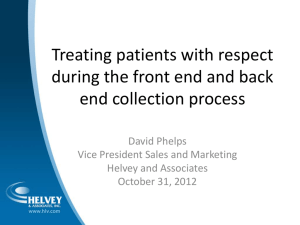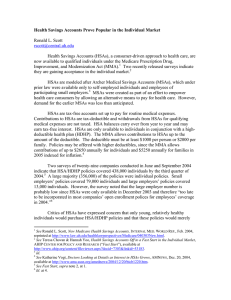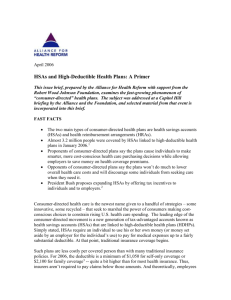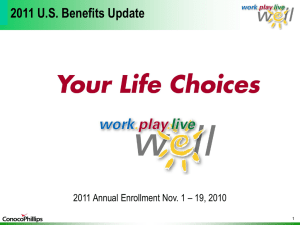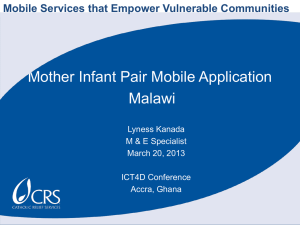Consumer-Directed Health Care and Health Care Rationing
advertisement
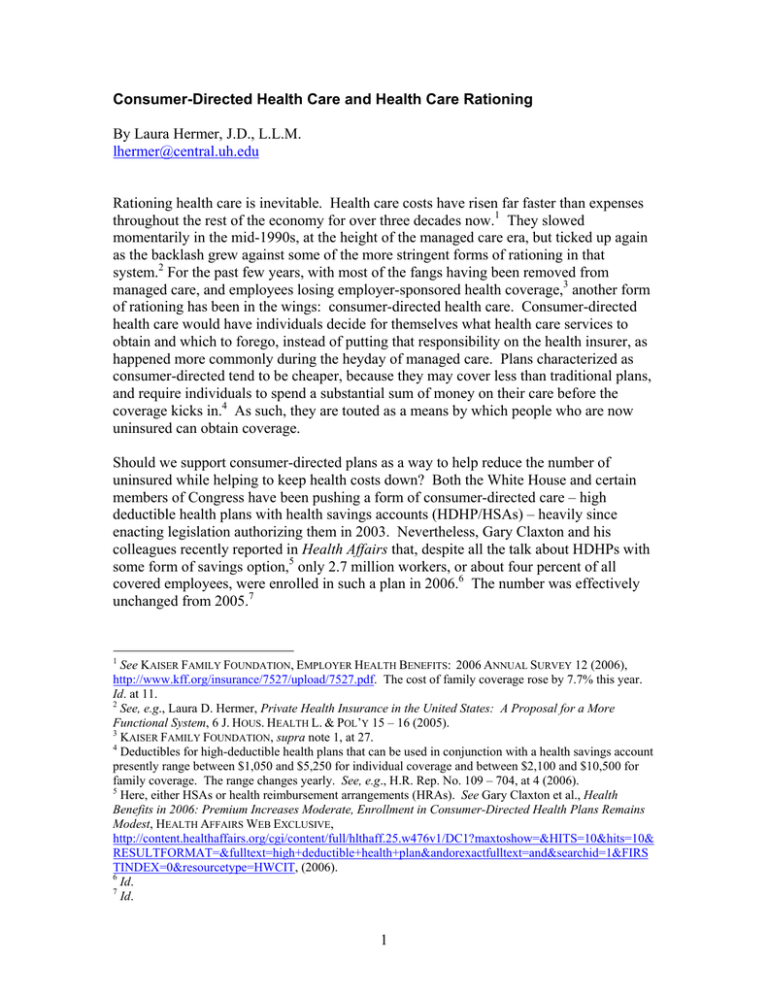
Consumer-Directed Health Care and Health Care Rationing By Laura Hermer, J.D., L.L.M. lhermer@central.uh.edu Rationing health care is inevitable. Health care costs have risen far faster than expenses throughout the rest of the economy for over three decades now.1 They slowed momentarily in the mid-1990s, at the height of the managed care era, but ticked up again as the backlash grew against some of the more stringent forms of rationing in that system.2 For the past few years, with most of the fangs having been removed from managed care, and employees losing employer-sponsored health coverage,3 another form of rationing has been in the wings: consumer-directed health care. Consumer-directed health care would have individuals decide for themselves what health care services to obtain and which to forego, instead of putting that responsibility on the health insurer, as happened more commonly during the heyday of managed care. Plans characterized as consumer-directed tend to be cheaper, because they may cover less than traditional plans, and require individuals to spend a substantial sum of money on their care before the coverage kicks in.4 As such, they are touted as a means by which people who are now uninsured can obtain coverage. Should we support consumer-directed plans as a way to help reduce the number of uninsured while helping to keep health costs down? Both the White House and certain members of Congress have been pushing a form of consumer-directed care – high deductible health plans with health savings accounts (HDHP/HSAs) – heavily since enacting legislation authorizing them in 2003. Nevertheless, Gary Claxton and his colleagues recently reported in Health Affairs that, despite all the talk about HDHPs with some form of savings option,5 only 2.7 million workers, or about four percent of all covered employees, were enrolled in such a plan in 2006.6 The number was effectively unchanged from 2005.7 1 See KAISER FAMILY FOUNDATION, EMPLOYER HEALTH BENEFITS: 2006 ANNUAL SURVEY 12 (2006), http://www.kff.org/insurance/7527/upload/7527.pdf. The cost of family coverage rose by 7.7% this year. Id. at 11. 2 See, e.g., Laura D. Hermer, Private Health Insurance in the United States: A Proposal for a More Functional System, 6 J. HOUS. HEALTH L. & POL’Y 15 – 16 (2005). 3 KAISER FAMILY FOUNDATION, supra note 1, at 27. 4 Deductibles for high-deductible health plans that can be used in conjunction with a health savings account presently range between $1,050 and $5,250 for individual coverage and between $2,100 and $10,500 for family coverage. The range changes yearly. See, e.g., H.R. Rep. No. 109 – 704, at 4 (2006). 5 Here, either HSAs or health reimbursement arrangements (HRAs). See Gary Claxton et al., Health Benefits in 2006: Premium Increases Moderate, Enrollment in Consumer-Directed Health Plans Remains Modest, HEALTH AFFAIRS WEB EXCLUSIVE, http://content.healthaffairs.org/cgi/content/full/hlthaff.25.w476v1/DC1?maxtoshow=&HITS=10&hits=10& RESULTFORMAT=&fulltext=high+deductible+health+plan&andorexactfulltext=and&searchid=1&FIRS TINDEX=0&resourcetype=HWCIT, (2006). 6 Id. 7 Id. 1 President Bush and various members of Congress have touted consumer-directed health plans as a means for the uninsured to obtain lower-cost health insurance.8 However, there are some problems with this plan. First, while the premiums for HDHPs indeed tend to be cheaper than those for traditional managed care plans, they also require significant out-of-pocket payments to meet the high deductible and cover any required co-payments.9 If one has no need for medical care during a given year, then the HDHP will likely have cost one less money than a traditional plan, and if one or one’s employer contributed money to one’s HSA or other health care spending account, then those funds will remain, earning interest, for future use.10 In such a case, one may indeed be better off with an HDHP with a savings option. However, if one has significant medical expenses, one may be better off in a more traditional health plan.11 Second, HDHP/HSAs, in particular, favor the wealthy by their very nature. The fact that one can put away tax-advantaged funds in an HSA and use them tax-free benefits one more strongly if one is in a higher rather than lower tax bracket. The federal government already heavily subsidizes private health insurance.12 HDHP/HSAs merely further that trend. Recently-proposed legislation regarding HDHP/HSAs, such as that sponsored by Rep. Eric Cantor, would serve only to drain more federal tax revenues from our coffers in support of health insurers, our private health insurance system, and our wealthier and healthier citizens.13 Decreased federal tax revenues mean fewer dollars for essential public health programs such as Medicaid and SCHIP that serve some of our most vulnerable members of society, at a time when the federal government is seeking to cut those programs even further than it already has in recent years.14 Meanwhile, a new study published in Health Affairs found that emerging data supports suggestions that HDHP/HSAs and other consumer-directed health plans do in fact hold 8 See, e.g., George W. Bush, President Participates in Panel on Health Savings Accounts (Apr. 5, 2006), available at http://www.whitehouse.gov/news/releases/2006/04/20060405-5.html. 9 For example, one recent study found that the average worker contribution to a traditional family premium in 2006 was $2,973, as compared to a contribution of $2,115 for a family HDHP. However, only eight percent of individuals in a traditional plan had a deductible of $1,000 or more, yet all in an HDHP did (the average deductible amount for single coverage was $1,442). 10 HRAs are the other major form of health care savings account used in conjunction with an HDHP. These accounts differ from HSAs in that only employers may contribute to them, and the employer may repossess any unused funds in an employee’s account if the employee leaves the job. See, e.g., Hermer, supra note 2, at 43; Claxton et al., supra note 5. 11 But see Dahlia K. Remier & Sherry A. Glied, How Much More Cost Sharing Will Health Savings Accounts Bring?, 25 HEALTH AFFAIRS 1070, 1075 (2006) (finding that only 42.2 percent of all individuals will face increased cost sharing with an HDHP/HSA, and that about half will experience reduced cost sharing). 12 The federal government will subsidize private health insurance with over $200 billion in foregone tax dollars in 2007. See Taking a Checkup on the Nation's Health Care Tax Policy: a Prognosis: Hearing Before the United States Senate Committee on Finance, 109th Cong. 2 (2006) (statement of Leonard E. Burman, Senior Fellow, Urban Institute). 13 See H.R. 6134, 109th Cong. (2006). 14 See, e.g., KAISER FAMILY FOUNDATION, THE PRESIDENT’S FY 2007 BUDGET PROPOSAL: OVERVIEW AND BRIEFING CHARTS 4 – 5 (2006), www.kff.org/uninsured/upload/7472.pdf. 2 health care use and spending down.15 Yet it appears that individuals reduced their use of both less useful care (e.g., emergency room care for non-urgent problems) and more useful care (e.g., ordered tests and follow-ups, care for “very serious problems,” etc.).16 At the same time, people who took up consumer-directed plans tended to have higher incomes and be in better health than those who took up other forms of health plans.17 The evidence regarding consumer-directed health plans is mixed. At the same time, they favor the healthy and wealthy in their incentives at the expense of the less well-off, and early evidence suggests that, in fact, those who are healthier and wealthier are more likely to choose an HDHP/HSAs. It is questionable whether we should be favoring those who are healthier and wealthier over the less well-off, particularly in the realm of health care. It may be time to reconsider our priorities, and decide whether better rationing strategies exist to help cut back on non-necessary care while ensuring that everyone has access to genuinely necessary medical care. October 2006 15 Melinda Beeuwkes Buntin et al., Consumer-Directed Health Care: Early Evidence About Effects on Cost and Quality, HEALTH AFFAIRS WEB EXCLUSIVE (Oct. 24, 2006), http://content.healthaffairs.org/cgi/reprint/hlthaff.25.w516v1. 16 Id. 17 Id. 3
